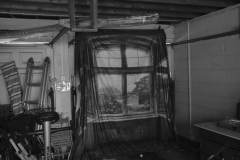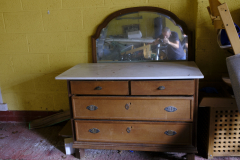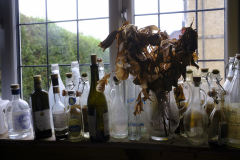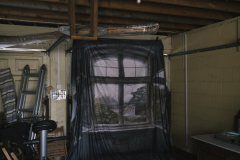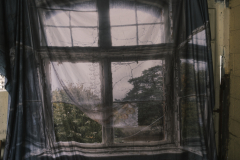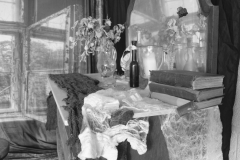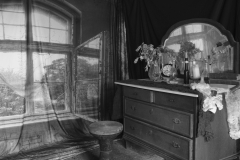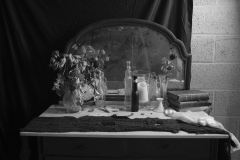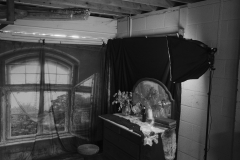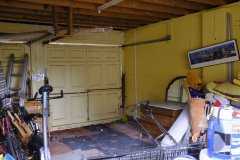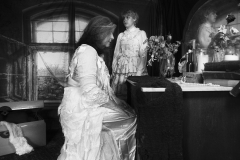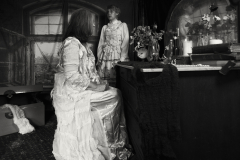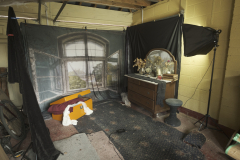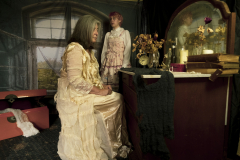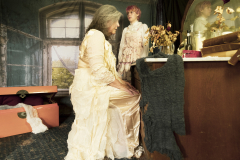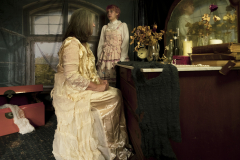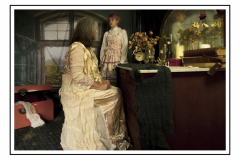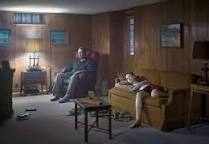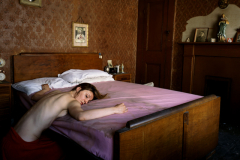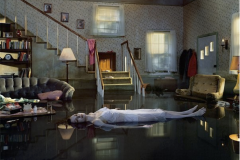Assignment 5 Image,Introduction & Illustrated Evaluation
Construct a stand-alone image of your choice. Alternatively, you may choose to make a series, elaborating on the same theme.
As the culminating assignment for the course you may wish to draw upon skills learned from Parts One to Four – using various forms of narrative, using yourself as subject matter, telling stories and reading images. The only stipulation is that you produce work that has been controlled and directed by you for a specific purpose. Remember to create a story with a specific context like the artists you’ve looked at in Part Five. This means you need to have an artistic intention, so a good place to start would be to write down some ideas. This could then form the basis for a 300-word introduction to the piece. You may find it helpful to draw storyboards to help you visualise your ideas.
The aim of this assignment is to use props, costumes, models, location, lighting, etc. to contribute to the overall meaning of the image. (Use flash/lights if required but available light is fine as long as it is considered.)
If the narrative is to be set in a different era then the elements of the image must reflect this. Also consider the symbolic meanings of objects and try not to be too literal in your approach. For example, don’t automatically use red roses in a love scene but try to be subtle in your ideas to obtain a more true-to-life scenario.
For this final assignment, you should also include an illustrated evaluation of the process you went through to produce your final image(s). Include snapshots of setting up the work and write about how you felt your direction went, how you found the location, props, etc. How did this process affect the final outcome? Write around 1,000 words in total (including your 300-word introduction).
Send your final image(s) to your tutor, along with your commentary and relevant pages of your learning log (or blog url).
Introduction
The image I’ve created was inspired by the Dickens character of Miss Havisham from the book Great Expectations.
In the story the character of Havisham, having been jilted (by letter) on the day of her wedding by the apprehensible Compeyson who conspired with her half -brother Arthur to swindle her of her fortune, becomes a recluse in her mansion never venturing out and surrounding herself with the artefacts of her aborted wedding. The shock of being abandoned and humiliated manifests itself both physically and psychologically. She stops all the clocks in the house (at 9:20 the time she got the letter) so she can no longer track the passing of time, continues to wear her wedding dress, wears only one shoe, and leaves the wedding cake and breakfast to rot as well as everything else connected to the wedding ritual.
She also adopts a young girl, Estella, and as the bitterness twists her mind, raises her to hate men,
“Break their hearts my pride and hope, break their hearts and have no mercy.”
Later in the story when she sees the hurt and damage that Estella unleashes she comments,
“What have I done?” “When she first came I meant to save her from misery like mine”
Although I first read the book over 35 years ago, the image of Miss Haversham has always resonated and stuck with me. The phycological shock of being jilted, rejected and swindled, pushed her into a mental breakdown trapping her in a moment that defined her mental and physical state for years. It occurred to me that her situation is almost a metaphor for a photograph, for example:
- she froze and got frozen in a moment in time
- she continued to live in that moment preserving it
- She frames her life physically within the confines of her mansion and mentally in the moment and shock of getting jilted
I wanted to create an image that contained elements of both Miss Havisham’s physical and mental condition and explore the idea that our minds can also freeze a moment in time with lasting consequences.
Creating the set and planning the image
The first challenge was the time period to situate the image. I was limited by the set I could create and had to get creative with regard to the props I could use. Initially, I had two ideas, one was to use a modern setting, using my living room, and the other my garage where I had an old dresser that was perfect but had limited space. I decided to shoot the image in my garage as I wanted a sense of decay and the old dresser and backdrop I bought helped me achieve that.
Building the set was another challenge and I had to reconsider and replan my vision on a number of occasions as the challenge of the set needed became clearer. As I was setting the scene in the mid-1800s I had to make sure that no modern elements were visible in the image- e.g. electricity wires, floor tiles, overhead beams etc. I bought a background that worked remarkably well but its dimensions were a bit off in relation to the people but I got away with it more or less. The height of the garage ceiling constrained the space I had to work in, and I end up condensing the shot into a corner to avoid any of the garage leaking into the frame.
As I planned the image, I considered the following:
-
- Every element within the frame to have a purpose
- Use of contrasts and opposites- young/old, decay/life , rags/riches, innocence/manipulation
- How to focus on both the physical and psychological aspects of Miss Havisham’s world-the time capsule and the manifestation of her twisted mind in Estella.
- Whether to shoot in colour or black and white-I had to create a setting with limited resources and often black and white is more forgiving-I also wanted to use lighting to enhance the feel of the image After shooting the images I opted for colour as I felt it worked well -especially using a warm light.
- Type of lens to use-I had to build a set in the garage and use a lens that would capture the scene within the set-it took some experimentation before I settled on 10-55mm zoom
- Use of lighting-I used warm lighting to give the scene a specific look and feel.
- Position of characters within the frame-Miss Havisham is dominant, use of a mirror to also reflect Estella, who is standing, slightly impatient and indifferent
Items within the set and their meanings
Wilted flowers-represents decay and the passing of time
Bottles-scene filler
Clock -stopped at 9.40, the time when she received the letter from Comyson informing her the wedding was off and when her heart and mind broke-suspension of time
Mirror-Over the years the dust obscured the real Miss Havisham, a form of denial, till she realised what she has created with Estella
Books- parallels to a Shakesperean tragedy of Miss Havishams actions
Backdrop-after some research I decided to buy a backdrop with open windows-this would signify the lens to the world outside
Costumes-wedding dress-Miss Havisham’s state of mind, stuck in the moment
Luggage-half packed, items discarded-part of the wedding day drama
Brief/ scenarios for the characters
The scene consists of two characters-Miss Havisham and Estella. It is one of realisation for Miss Havisham that Estella has caused the same pain she herself suffered and that she can no longer control her.
For Miss Havisham it’s the realisation that you ‘reap what you sow; for Estella, it’s one of indifference as she knows no different having been raised that way.
Research
Noémie Goudal’s practice involves the construction of ambitious staged, illusionistic installations within the landscape, documented using film and photography. Goudal’s interventions are under pinned by rigorous research examining the intersection of ecology and anthropology, interrogating the limitations of theoretical conceptions of the natural world. Noémie Goudal (b. 1984) lives and works in Paris. In 2010, she graduated from the Royal College of Art, London, UK.(http://noemiegoudal.com/infos accessed 29/08/2022)
‘Photography is a tool for me, a simple instrument,in the same way as video, installation or performance.But what I’m most fascinated by is the construction of images and what one can make believe inside an image’
Goudal’s work uses different media of which photography is just one among many. Looking at her work, and how she researches and iterates her ideas has taken me into what she describes as ‘the construction of images and what one can make-beleive inside an image’ and how to create images yet retain believability.
Gregory Crewdson was born in Brooklyn, and his elaborate tableaux use motion picture techniques and production values to achieve their style and effect. He photographs tableaux of American homes and neighbourhoods. Crewdson’s images (for this author) are like mini-movies to be poured over and picked apart to unlock their meaning. They are perfectly composed and crafted, and he uses the toolset of movie-making to highlight elements of a scene as well as planting clues in the settings. His complex use of light lends atmosphere and helps, in some images, to communicate psychological tensions at play. For me, he brings photography and narrative to another level and opens up endless possibilities to capture or as he says himself,
‘This idea of creating a moment that’s frozen and mute, that perhaps ultimately asks more questions than it answers, proposes an open-ended and ambiguous narrative that allows the viewer to, in a sense, complete it. Ultimately, I’m interested in this ambiguous moment that draws the viewer in through photographic beauty, through repulsion, through some kind of tension’
Jeff Wall is a Canadian artist and writer whose images are often large-scale and elaborate mise-en-scenes presented on large light boxes. Reading about his creative process when making his now famous ‘Wind’ (1993) inspired and helped me with this image. Looking at his images and the way he goes about creating them made it clear that I had much more tools at my disposal including staging (and re-staging) and digital manipulation.
Reflection
This is the first time I’ve created an image that I’ve constructed and considered in detail the different elements-composition, sets, props, actors, costumes, and lighting- to create a visual narrative. Creating a physical set and marrying it with the narrative I wanted to create was a challenge and I had to improvise and work with many different elements to bring them into a cohesive whole.
In general, I have achieved that and have produced an image that tells a story or offers enough for the viewer to create his/her own interpretation. Elements within the image are considered; for example, the wilted flowers, the dress, and the clock represent both the pausing and passing of time. The mirror is covered in a film of dust (passing of time) and prevents Miss Havisham from seeing the reality of her situation clearly – in the image, she gazes into the mirror but only sees Estella-her creation, a reflection of her twisted logic and driven by her broken heart.
In creating the image, I borrowed bits and pieces from different sources-film, staged tableaux, painting, and photographic theory and practice. My camera became a mere tool to capture the scene I created rather than ‘faithfully’ capturing a truth. Unlike the book, (Great Expectations), where the story unfolds page after page, I was aware that in the image the viewer receives all the information at the same time and brings his/her worldview to bear when interpreting or reading the image. I also wanted the image to work on its own if the viewer was not familiar with Miss Havisham’s character. I reflected on the different codes that would be at play, the signifiers of its syntax -Miss Havisham is old, Estella young, rags (wedding dress) and the finery of Estella’s clothes-a series of contrasts and opposites that would help give the picture composition and meaning.
For all that, I felt like someone with new tools and a head full of theory and strove to bring it all together. Although I was using my camera I didn’t feel like I was taking a photograph, but rather creating an image, a piece of art. The mental model I employed shifted from ‘look, compose, shoot’ to one of creation and infinitely more possibilities.
I would also have liked more time to refine and build my set and as I looked at and ‘lived’ with the image more, I begin to see things that I could have done differently-for example, I would have liked to have had another clock or timepiece stopped at 9:20 to drive home that ‘mystery’, I could have changed my shooting angle to incorporate more of the dresser and create more narrative around the items on it-unfortunately I had to dismantle the set and my model was no longer available so didn’t re-shoot.
A key takeaway from this exercise was that photography offers infinite possibilities to create or contribute to creating art.
——————————————————————————————————————————————–
Further reflection after tutor feedback
A key piece of feedback from my tutor:
…This is fine but I would like to have seen a deeper reflection upon the implications of symbol and meaning in this work within a critical framework coupled with an evaluation considering if you resolved your stated intentions in the final outcome…..’However, at whatever level we view the image we can still relate to it but without the preamble from the learning log how would the image be viewed? Where would this image be presented and how would this influence meaning? Does the image contain depths of meaning or is it an illustration for a book, an album cover, a magazine article or a gallery piece?’
Creating an image like this was like doing a clue for a cryptic crossword-I wanted to leave hints for people to decipher, and my goal was to show that Miss Havisham’s world was like a metaphor for a photograph-her mind froze the day she got jilted, and this manifested itself in her physical appearance and surroundings. Within the image I attempted to use different elements in opposition or contrasts to communicate its meanings:
- Wilted flowers-represents decay and the passing of time / the window and beyond-living world-life going on
- Clock -stopped at 9.40, the time when she received the letter from Comyson informing her the wedding was off and when her heart and mind broke-suspension of time
- Mirror-Over the years the dust obscured the real Miss Havisham, a form of denial, till she realised what she has created within Estella / reflects the younger girl
- Books- parallels to a Shakesperean tragedy of Miss Havisham’s actions
- Costumes-dishevelled wedding dress-Miss Havisham’s state of mind- ‘stuck in the moment’ / Estella is well dressed, well kept
- Luggage-half packed, items discarded-part of the wedding day drama
- Sitting (resigned) / standing (impatient)
The image works best when viewed in the context of Miss Havisham, and when making it I didn’t give enough thought to how it might come across without that backstory. Obviously, it could work as an illustration in a book, but I would want it to work stand-alone too. If you are part of the minority who are educated in the language of photography and reading images you will most likely take something from it stand-alone, and no doubt find much more than I intended (reference the copious amounts of analysis on ‘famous’ photographs!). If you encountered it in a gallery you would no doubt buy into the unwritten contract that it must be special and communicating something, is worth your time to stop and look and search, unravel the layers of meaning.
So did I achieve what I set out to do? To a degree.. I might have achieved more, things I never thought of, and that’s the beauty and the malleability of images when photographer, context and viewer intersect.
References
A sudden gust of wind https://www.tate.org.uk/art/artworks/wall-a-sudden-gust-of-wind-after-hokusai-t06951 (accessed 15/08/2022)
Bate,David, 2019,Photography Key Concepts,London,Bloomsbury
Bright,Susan,2014, Art Photography Now, London,Thomas & Hudson
Dahmani,Taous,2022,In Studio with Noemie Goudal,British Journal of Photography,pp. 145-153
LaGrange, Ashley, 2005, Basic Critical Theory for Photographers, London: Taylor & Francis Group
Lubow,Arthur, 2020, For Gregory Crewdson, Truth Lurks in the Landscape https://www.nytimes.com/2020/08/20/arts/design/gregory-crewdson-berkshires-photography.html accessed 01/08/2020
http://www.tomhunter.org/ (accessed 25/08/2022)
https://www.tate.org.uk/art/artists/jeff-wall-2359 (accessed 20/08/2022)





